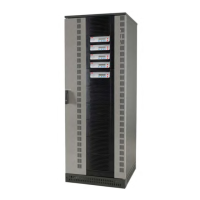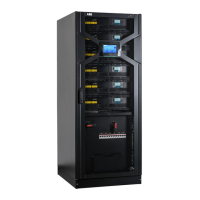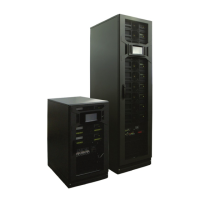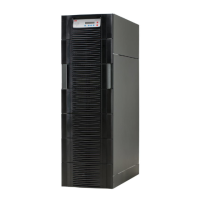04-3275_OPM_ABB_CONCEPTPOWER_DPA_500kW_EN_REV-A.docx Page 26/78 ABB
Modifications reserved
5 CONNECTIVITY
5.1 INTERFACING
Each UPS cabinet is provided with customer interface ports (also called communication ports) which provides
information about the UPS (single units) or the UPS system (parallel system).
The customer interface is composed by (see also the figure 12 at the end of this section):
• Slot for optional Modem card
• Slot for optional SNMP card
• PC / laptop connection JD1 (RS232 Sub D9/female) or USB
• Status LED’s 1 red LED and 1 green LED
• Graphical display connection JR3 (RJ 45)
• Multidrop configuration SW2 (DIP-SWITCH)
• Multidrop connection JR2 (RJ 45)
• UPS inputs X3 (Phoenix terminals)
• 12VDC source X3 5/6 (Phoenix terminals)
• UPS outputs, dry ports X2 (Phoenix terminals)
• Interlock Function X1 1/2 (Phoenix terminals)
• Multi-Cabinet Configuration SW1-6 (DIP-SWITCH)
• Parallel BUS connector JD8 (Sub D25/female)
5.1.1 SMART PORT JD1 on each frame (Serial RS 232 / Sub D9 / male)
The SMART PORT JD1 located on the customer interface board (see figure 10 above, detail 9) RS 232 serial port
that allows the UPS Module to be connected to a computer. The connector is a standard D-Type, 9-pin, male.
When installed the optional SMART PORT, the software WAVEMON allows the computer to monitor the mains
voltage and the UPS status continuously.
In the event of any changes the computer terminal will display a message.
(For details see our Monitoring Package: WAVEMON ).
The figure 11 shows how to connect a PC to the UPS with different Sub-D connectors.
Interface Cable (UPS End) Interface cable (Computer End)
(9-Pin, D-Type Male) (9-Pin, D-Type Female)
Connects to UPS Connects to
JD1 Computer
Figure 11: Connector Cable - PC Serial Port with 9-Pin Connection

